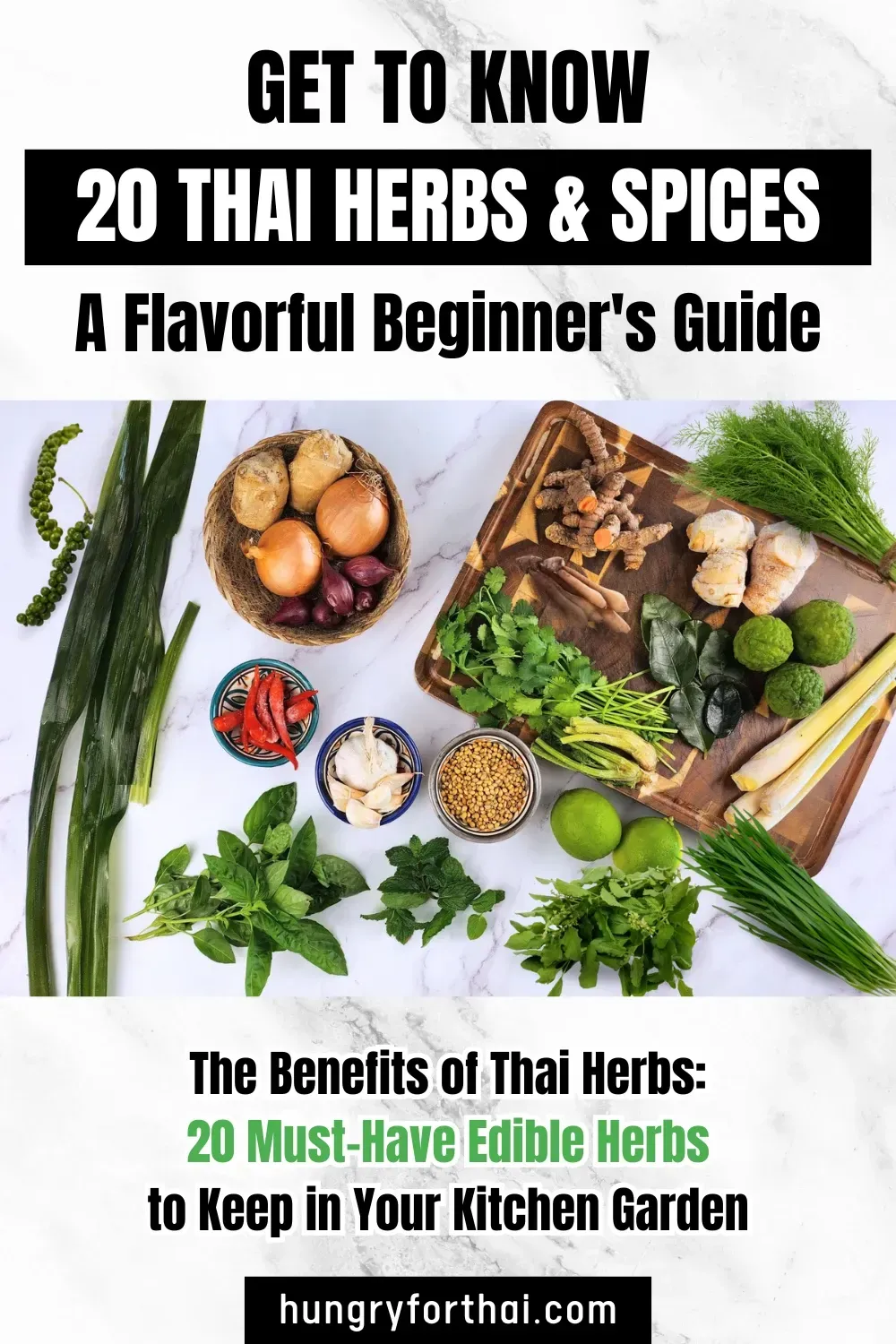Get to Know 20 Thai Herbs & Spices: A Flavorful Beginner's Guide
By Sho @ Hungry for Thai
on
Jun 9th 2025 
Thai food is famous around the world.
Even people who've never been to Thailand have likely had the chance to enjoy a Thai meal.
What makes Thai cuisine so unique and globally loved is its distinctive taste, which comes from the way it's cooked and the use of flavorful herbs and spices.
Thai herbs are the heart of many dishes — and nowadays, they're easy to find in fresh, dried, powdered, or seed form (perfect for planting at home!).
Once you've got the key ingredients, cooking authentic Thai dishes becomes much easier — you're already halfway there!
When I was growing up, my grandmother used to plant herbs and vegetables along the fence of our house.
Whenever she cooked, she'd send me out to pick fresh herbs.
Every week, I had to water the plants and help tend the garden.
That's how I became so familiar with Thai herbs.
Even after moving abroad, I've continued to grow a few herbs that can handle the climate here.
These herbs are not only delicious and easy to use, but they also add depth to your dishes and provide natural wellness boosts for the whole family.
You can whip up all kinds of tasty meals with them and stay healthy while you're at it!
So now, let's dive into 20 essential Thai herbs and garden veggies that are both tasty and beneficial.
Ready? Let's get started! 🌿✨

1. Galangal (Kha) – Zesty and Peppery with a Kick
Galangal is a root similar to ginger but with its own unique flavor.
It's a key ingredient in many Thai dishes, adding a special touch that's hard to replace.
Galangal is widely used across Thailand, especially in central and southern regions, where its bold flavor complements the spicy and aromatic profiles of local dishes.
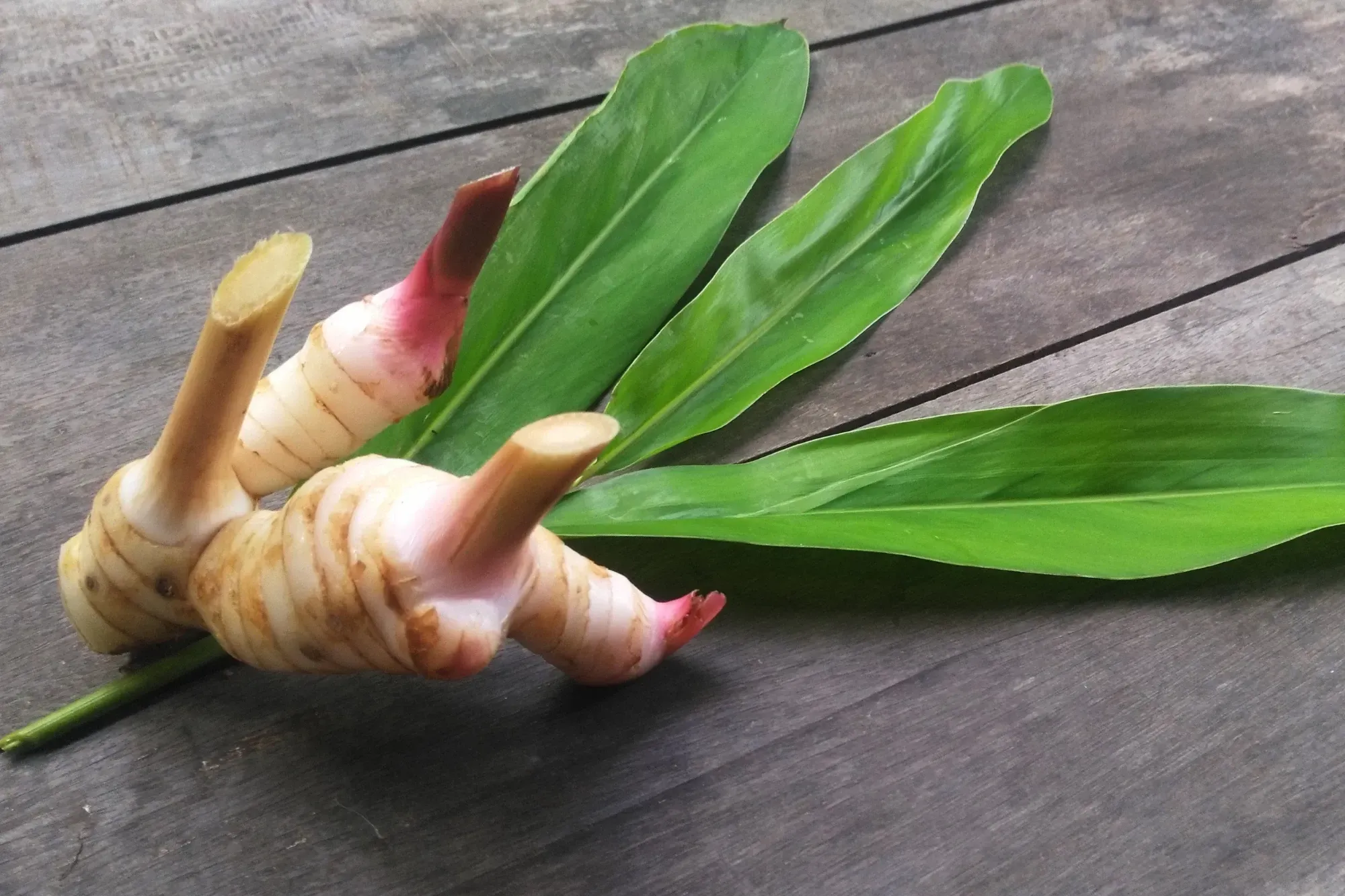
What Does It Taste Like?
It has a warm, peppery taste with hints of citrus, giving Thai food its distinctive zing.
Health Benefits
Galangal is known for aiding digestion and reducing inflammation, making it a healthy addition to your meals.
How Do Thais Use It?
It's used in various forms—sliced, crushed, or pounded into pastes—for dishes like:
- Soups: Such as Tom Yum Goong (spicy shrimp soup) and Tom Kha Gai (coconut chicken soup).
- Curry Pastes: It's blended into pastes for different curries, adding depth and aroma.
- Stir-Fries and Marinades: Enhances the flavor of various meat and vegetable dishes.
Storage Tips
Keep fresh galangal in the freezer, wrapped in a paper towel and placed in a plastic bag, to maintain its freshness.
Here are some links to recipes that uses galangal: Chicken Coconut Soup (Tom Kha Gai) and Thai Chicken Noodle Soup — check them out!
2. Coriander or Cilantro (Pak Chee) – Fresh, Citrusy, and Full of Flavor
Known as phak chi in Thai, is an herb whose leaves, stems, roots, and seeds are all used in cooking, each offering a different flavor.
It is used throughout Thailand, with its roots and seeds being particularly prevalent in central and northern regions, where they are essential in crafting the complex flavors of traditional dishes.
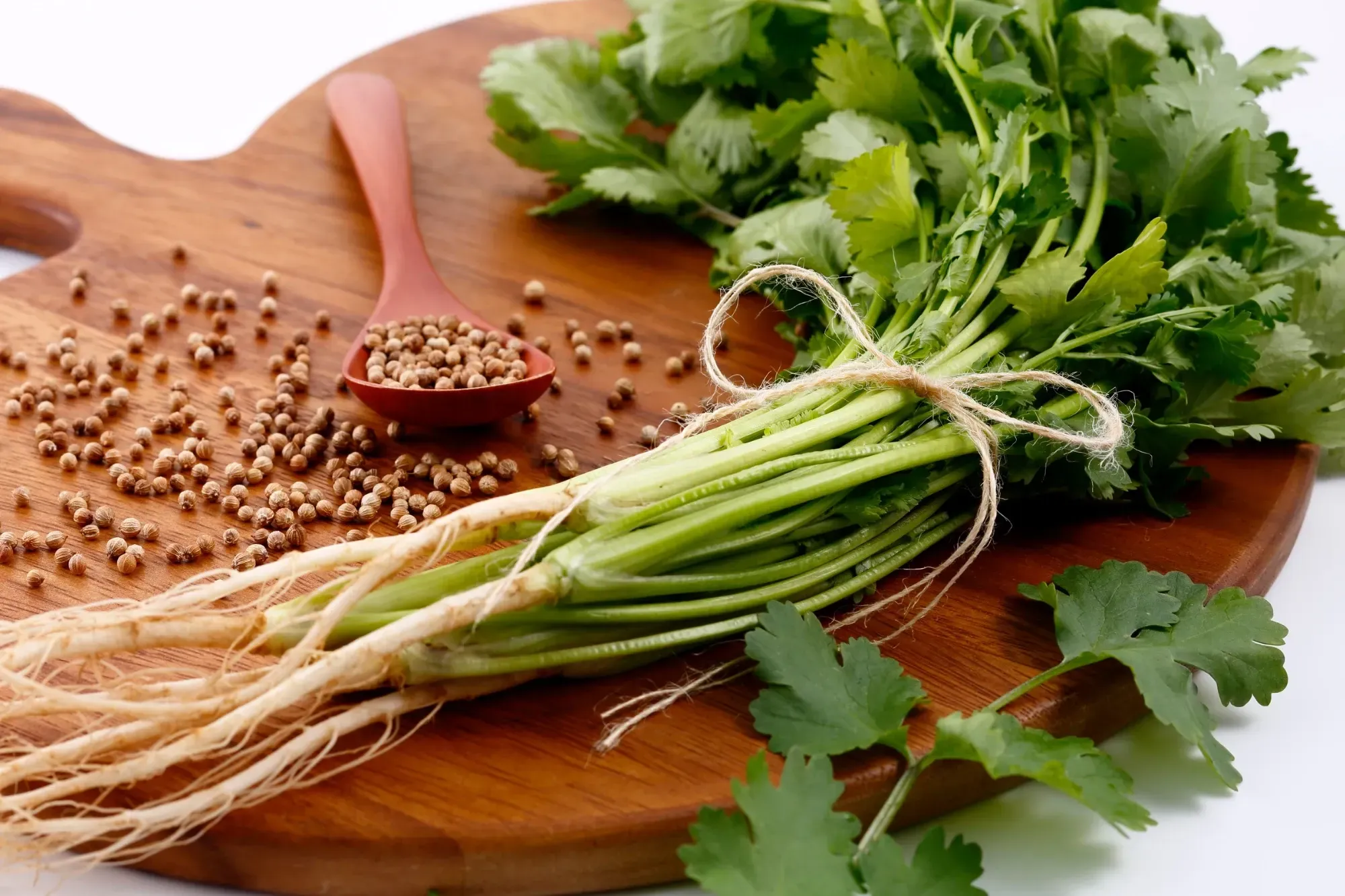
What Does It Taste Like?
The leaves have a fresh, citrusy flavor, while the roots are more intense and peppery.
The seeds, when dried, provide a lemony, floral aroma with a slightly nutty, citrusy taste.
Health Benefits
Coriander is rich in antioxidants and aids digestion, making it a flavorful and healthy choice for your dishes.
How Do Thais Use It?
All parts of the plant are utilized:
- Leaves: Used fresh as a garnish for soups, salads, and main dishes.
- Roots: Pounded with garlic and chilies to form the base of curry pastes and marinades.
- Seeds: Ground into powder and used in spice mixes and curry powders.
Storage Tips
Store fresh coriander leaves in the refrigerator, wrapped in a damp paper towel inside a plastic bag, to keep them fresh longer.
Or Keep fresh coriander leaves and roots in the freezer, air tight container.
Here are some links to recipes that use coriander (cilantro): Authentic Thai Laab Moo and Homemade Roasted Chicken with Thai Herb — check them out!
3. Garlic (Kra Tium)– A Must-Have in Thai Cooking
A small, white bulb, and a staple in Thai cooking, garlic adds depth to dishes and is known for its immune-boosting and heart health benefits.
In Thailand, we often enjoy raw garlic alongside rich, fatty dishes like Khao Kha Moo (braised pork leg over rice) or Pa-Lo (five-spice stew).
You'll also find garlic flavor prominently featured in Pad Kra Pao (Thai basil stir-fry).
Additionally, garlic is the star ingredient in dishes like Khao Moo Tod Kratiem or Khao Gai Tod Kratiem—deep-fried pork or chicken with garlic.
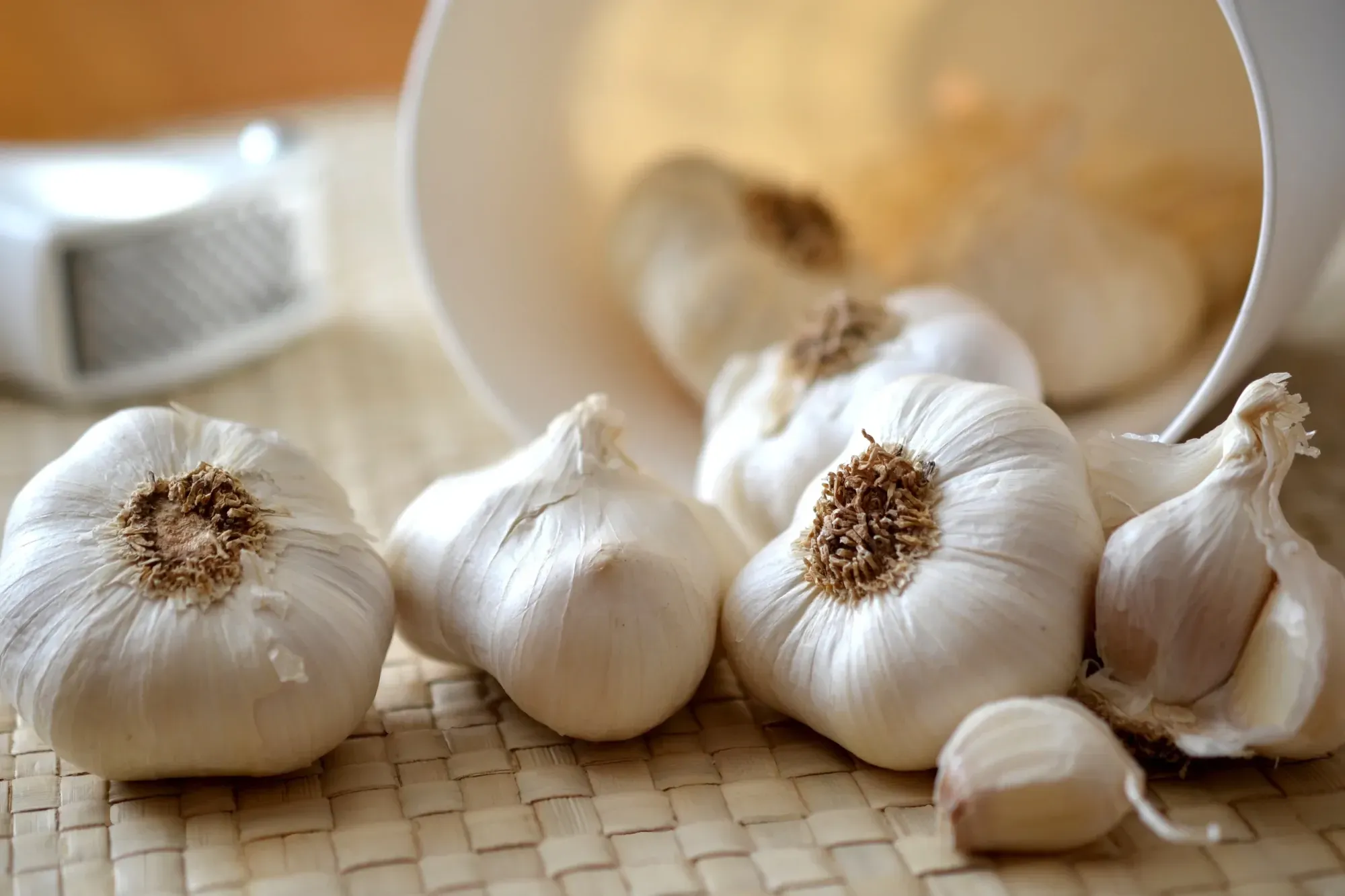
What Does It Taste Like?
It has a strong, pungent flavor that becomes milder and sweeter when cooked
Health Benefits
Garlic is known for boosting the immune system, reducing inflammation, and supporting heart health.
How Do Thais Use It?
Used in various forms—crushed, chopped, or minced—for dishes like stir-fries, curries, and dipping sauces.
Storage Tips
Store garlic in a well-ventilated, dry area to prevent mold growth, and away from direct sunlight to prevent sprouting.
Here are some links to recipes that use garlic: Spicy Thai Basil (Pad Kra Pao), Pa-Lo (five-spice stew) and Thai Chicken Noodle Soup — check them out!
4. Holy Basil (Ka Prow) – A Thai Kitchen Favorite
Holy basil (known in Thai as krapow) is one of the most popular herbs in Thai home gardens.
It has a distinct, aromatic scent that's hard to miss, and it's the star of one of Thailand's all-time favorite dishes — Pad Krapow!
But krapow isn't just for stir-fries. You can use it in all kinds of Thai recipes.
A fragrant herb with peppery leaves, essential in Thai cuisine. Known for its spicy, peppery flavor.
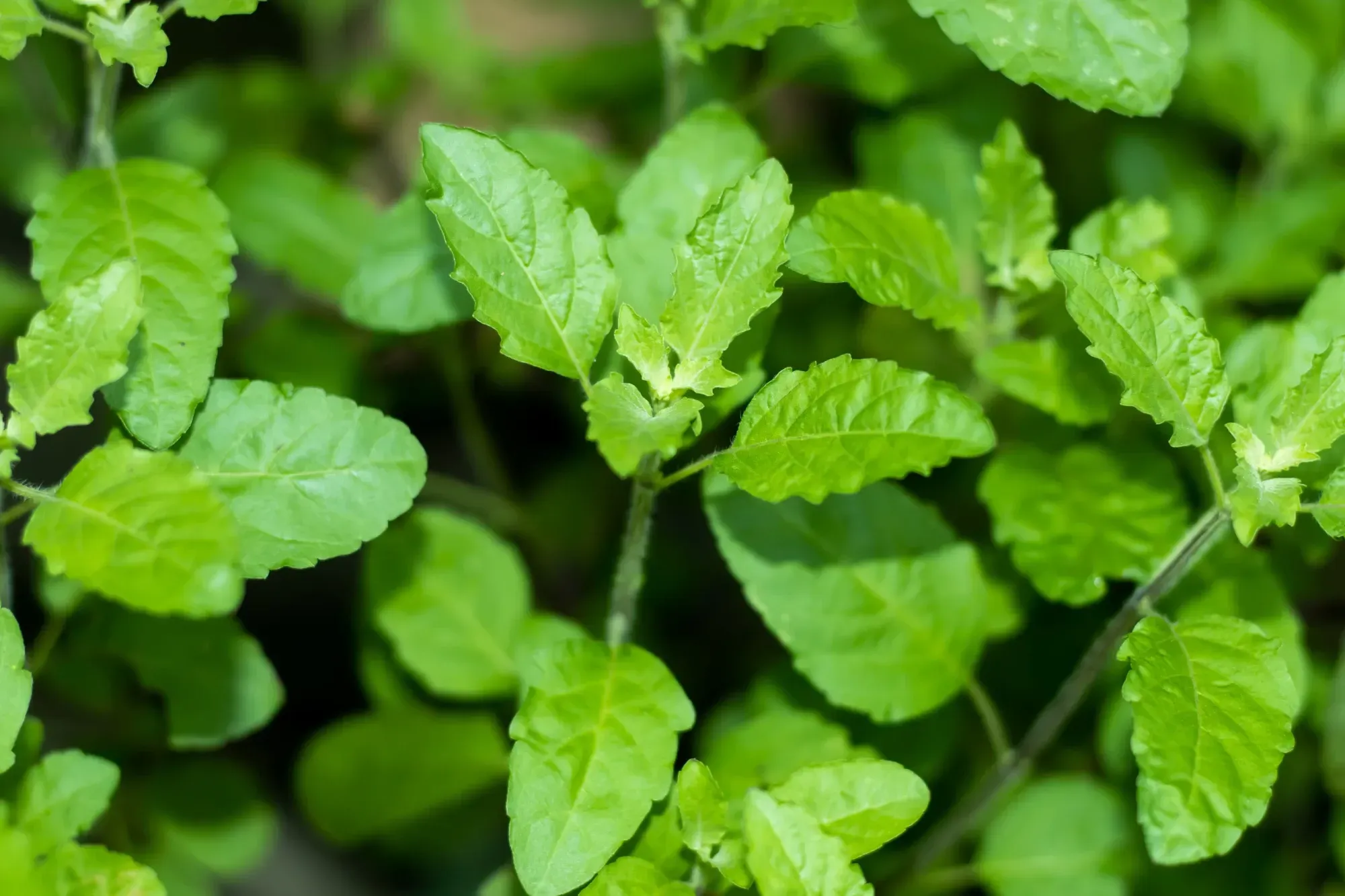
What Does It Taste Like?
It has a spicy, slightly bitter flavor with a hint of clove.
Health Benefits
It's also known for its medicinal benefits. Traditionally, it's used to help relieve coughs, ease cold symptoms, reduce bloating and gas, and boost the immune system.
Plus, it can even help freshen your breath naturally.
How Do Thais Use It?
Key ingredient in dishes like Pad Krapow (stir-fried basil), often paired with minced meat and chilies.
Storage Tips
Keep in the refrigerator wrapped in a damp paper towel to maintain freshness.
Here's a link to a recipe that uses holy basil: Stir-Fried Thai Basil (Pad Ka Prow-Vegetarian) — check it out!
5. Ginger (Khing) – The Spicy Root with Superpowers
A spicy root used to add warmth and depth to Thai dishes.
Known for its bold, spicy kick, ginger is a powerhouse herb used in both cooking and traditional remedies.
Most people like to boil mature ginger and drink the warm infusion — it's one of the best ways to get all the health benefits packed into this root!
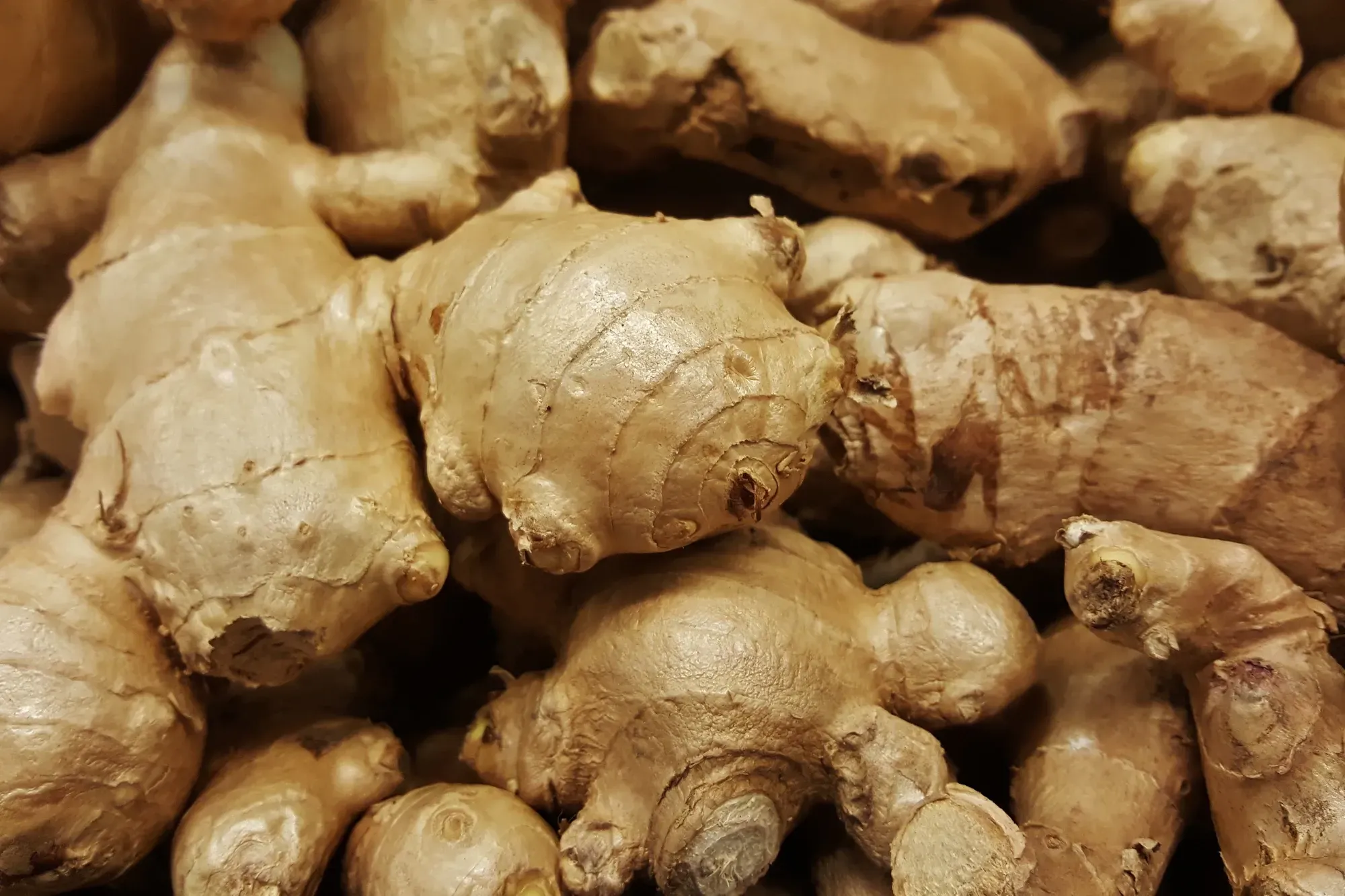
What Does It Taste Like?
It has a sharp, spicy flavor with citrus undertones.
Health Benefits
Ginger is known to help fight off cold and flu viruses, ease coughs, and break up mucus.
It's also loaded with antioxidants that help reduce inflammation, lower the risk of certain cancers, and strengthen your immune system.
How Do Thais Use It?
Used fresh in soups, curries, and stir-fries (Stir fried ginger with chicken), steamed fish, or dried in spice mixes.
Storage Tips
Store in the refrigerator to keep it fresh longer.
Here are some links to recipes that use ginger: Ginger Stir-Fried Chicken and Ginger Steamed Fish — check them out!
6. Lime (Ma Now) – The Zesty Star of Thai Cooking
A small, green citrus fruit providing tangy juice and aromatic zest.
Lime is that tangy little fruit that brings a bold, punchy flavor to so many Thai dishes — think yum (Thai salads), som tum (papaya salad), tom yum, and all sorts of dipping sauces.
It's practically a must-have in any Thai kitchen!

What Does It Taste Like?
It offers a sharp, refreshing sourness.
Health Benefits
it's also packed with vitamin C and comes with a bunch of health benefits.
It can help soothe sore throats, reduce inflammation in the tonsils, clear up congestion, calm a cough, and break up mucus.
How Do Thais Use It?
Juice and zest are used in dressings, marinades, tom yum, and to balance flavors in various dishes.
Storage Tips
Keep in the refrigerator to prolong freshness. Or you can squeeze fresh lime juice and freeze it for long-term use.
It's a great way to keep that zesty flavor on hand anytime you need it!
Here are some links to recipes that use lime: Easy Yum Woon Sen and Grilled Pork Salad with Cucumber — check them out!
7. Thai Chili Peppers (Prik)– The Spicy Star of Thai Cuisine
Thailand is home to many varieties of chili peppers, but what really makes them famous is their fiery heat!
That heat comes from a natural compound called capsaicin, which gives chili its signature spicy kick.
But chilies aren't just about heat — they're also packed with health benefits! 💪
Chilies also play a big role in Thai cooking.
They're used to add spice, color, and flavor in all kinds of dishes — from soups and salads to curries, stir-fries, and dipping sauces.
It's hard to imagine Thai food without them!
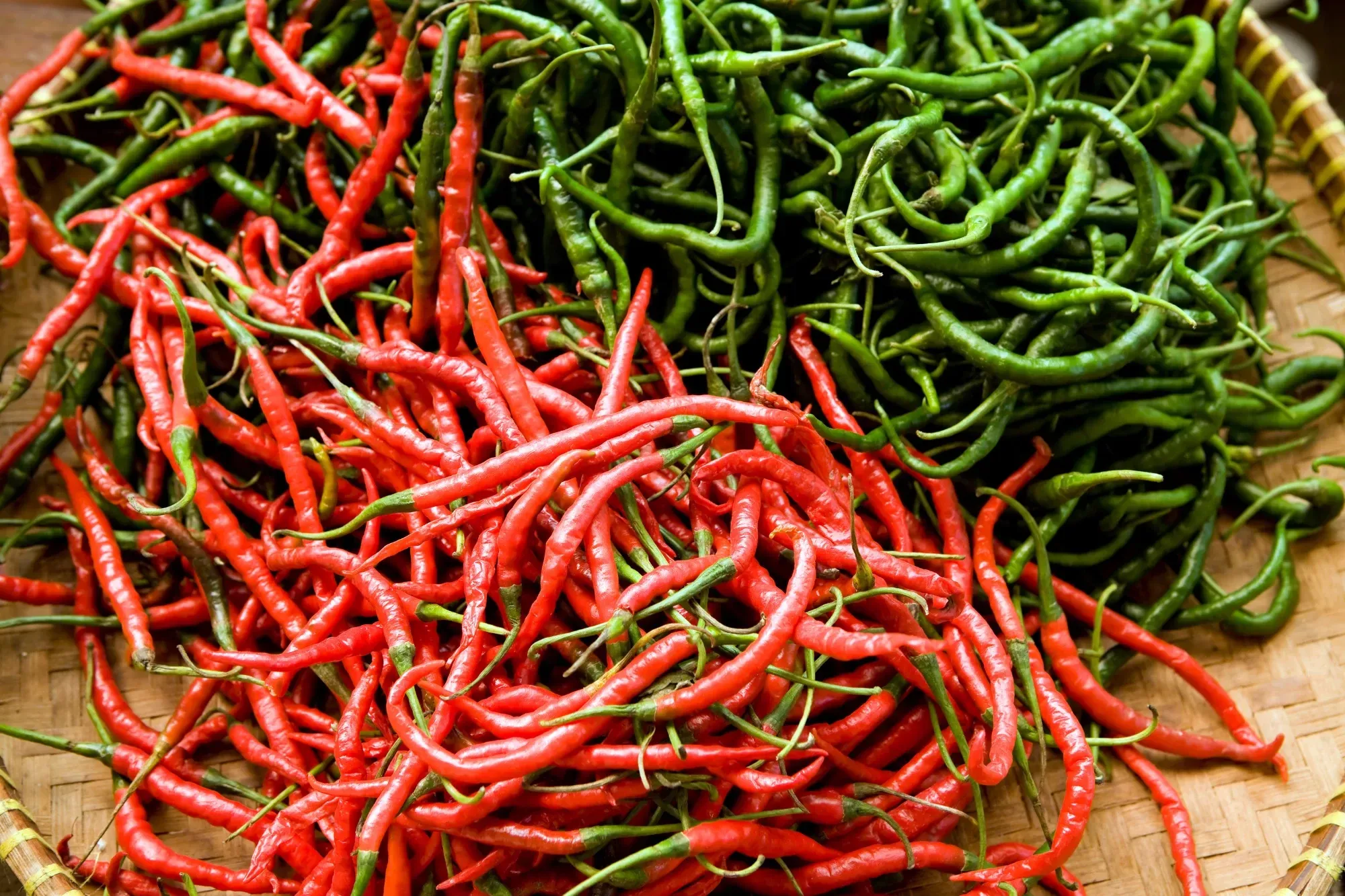
What Does It Taste Like?
Ranges from mildly spicy to extremely hot, depending on the variety.
Health Benefits
- Help boost your immune system
- Rich in antioxidants
- May help lower cholesterol levels
- Aid digestion and increase appetite
- Can help relieve nausea, gas, and even stimulate sweating
How Do Thais Use It?
Used fresh, dried, or in pastes to add heat to dishes like curries, soups, and stir-fries.
Storage Tips
Store fresh chilies in the refrigerator; dried chilies can be kept in a cool, dark place.
Here are some links to recipes that use chili: Crispy Pork Belly with Kale and Spicy Thai Basil (Pad Kra Pao) — check them out!
8. Thai Sweet Basil (Ho Ra Pha) – Fragrant and Flavorful
Thai sweet basil (horapha) is a wonderfully aromatic herb that's widely used in many Thai dishes.
It adds a fresh, inviting flavor to food and also helps reduce strong or fishy smells in certain ingredients.
The leaves and tender tips are often tossed into soups, stir-fries, or sprinkled on top as a finishing touch.
You can also enjoy the fresh leaves as a side with savory dishes or snacks — they're super versatile!
Bonus: Thai sweet basil is rich in beta-carotene, which may help protect against heart disease and certain types of cancer.
So it's not just tasty — it's good for you, too!

What Does It Taste Like?
It has a spicy, slightly sweet flavor with hints of anise.
Health Benefits
- Boosts your immune system – Helps keep your body strong and ready to fight off illness.
- Eases bloating – A natural remedy for uncomfortable, gassy tummies.
- Promotes relaxation – Its soothing aroma can help reduce stress and calm your mind.
- Lowers cholesterol – May help support heart health by reducing blood cholesterol levels.
- Relieves nausea – Great for calming an upset stomach and easing the feeling of nausea.
How Do Thais Use It?
Commonly used in stir-fries, salads, curries, and as a garnish.
Storage Tips
Keep in the refrigerator wrapped in a damp paper towel to maintain freshness.
Here are some links to recipes that use Thai sweet basil: Green Chicken Curry and Thai Bamboo Shoot Curry — check them out!
9. Lemongrass (Tra Khai) – Citrusy, Fresh, and Soothing
Lemongrass has been a part of Thai life for generations — you’ll find it growing in many home gardens across the country.
It’s more than just a kitchen staple; today, lemongrass is also an important economic crop for Thailand.
Besides being a delicious ingredient in Thai cooking, lemongrass is also a natural bug repellent! 🦟✨
Lemongrass has a fresh, citrusy fragrance that runs through the entire plant — and luckily for us, mosquitoes and small insects (like gnats) really don’t like it.
That’s why it’s often used in natural ways to keep bugs away, especially in gardens and outdoor areas.
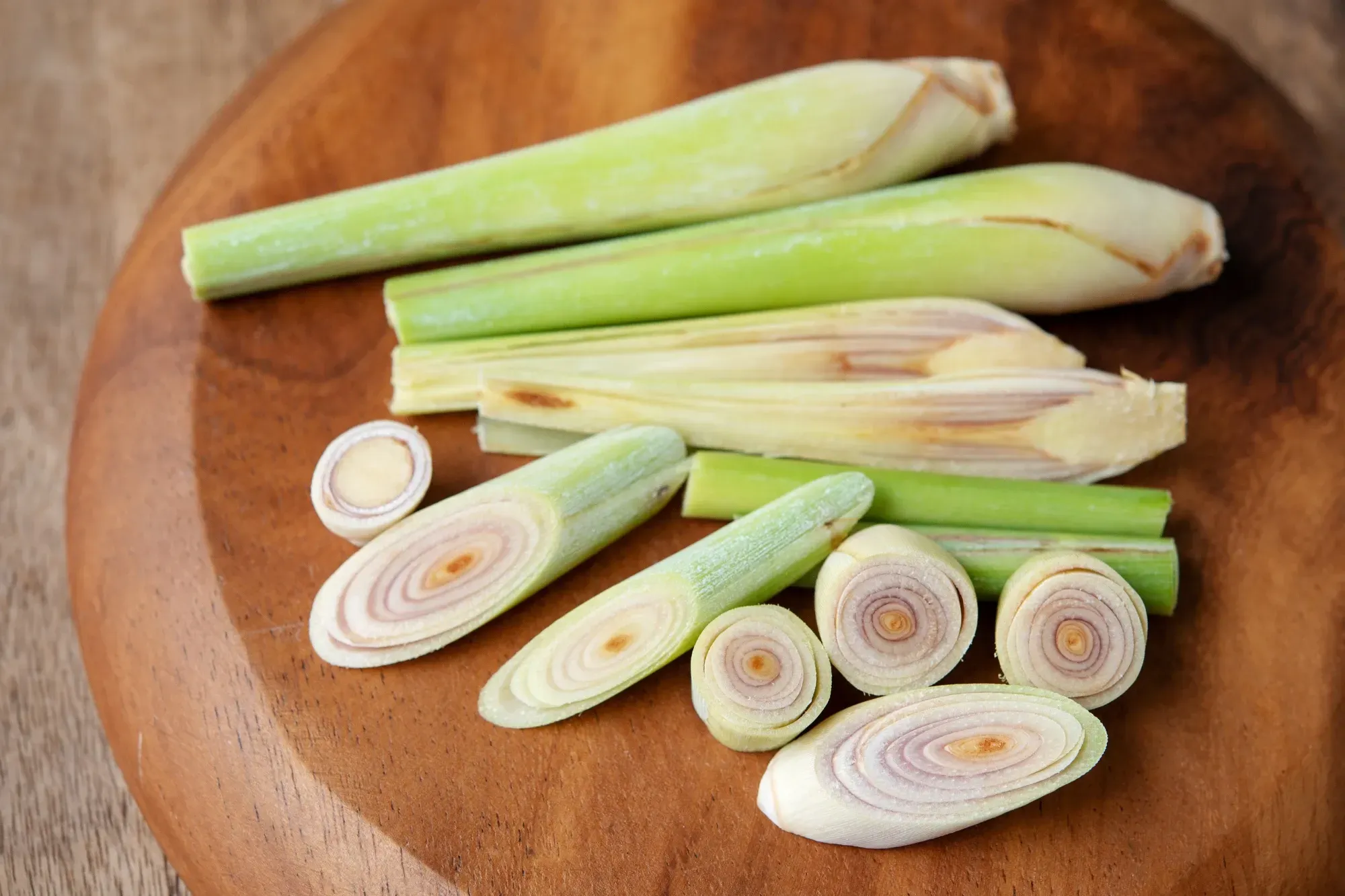
What Does It Taste Like?
It’s not just fragrant — lemongrass also has a bold, zesty flavor with a bit of spicy kick, making it a favorite in both cooking and traditional remedies.
Health Benefits
Lemongrass isn’t just flavorful — it’s good for you too!
It’s packed with helpful vitamins and minerals like vitamin A, calcium, phosphorus, and iron.
Traditionally, it’s also been used as a natural remedy in Thai medicine.
How Do Thais Use It?
This fragrant herb plays a big role in Thai cooking.
You’ll find it in classic dishes like Tom Yum (spicy soup), curries, spicy salads (yam), and grilled meat salads (plah).
It’s also blended into curry pastes and even stir-fried dishes.
Storage Tips
To keep your lemongrass fresh, start by choosing fresh, firm stalks.
Trim off any dry or tough parts, then soak the lemongrass in water for a bit.
After that, wrap it in a damp cloth and store it in the fridge to help it stay crisp and flavorful longer.
Here are some links to recipes that use lemon grass: Homemade Roasted Chicken with Thai Herb and Chicken Coconut Soup (Tom Kha Gai) — check them out!
10. Shallot (Hom Daeng) – Sweet, Aromatic, and a Thai Kitchen Essential
Shallots are a staple ingredient in Thai cooking, loved for their ability to add depth and sweetness to dishes.
In fact, shallots are used in almost every Thai curry paste, making them an essential part of the kitchen.
You could even say, without shallots, many Thai dishes just wouldn’t be the same!
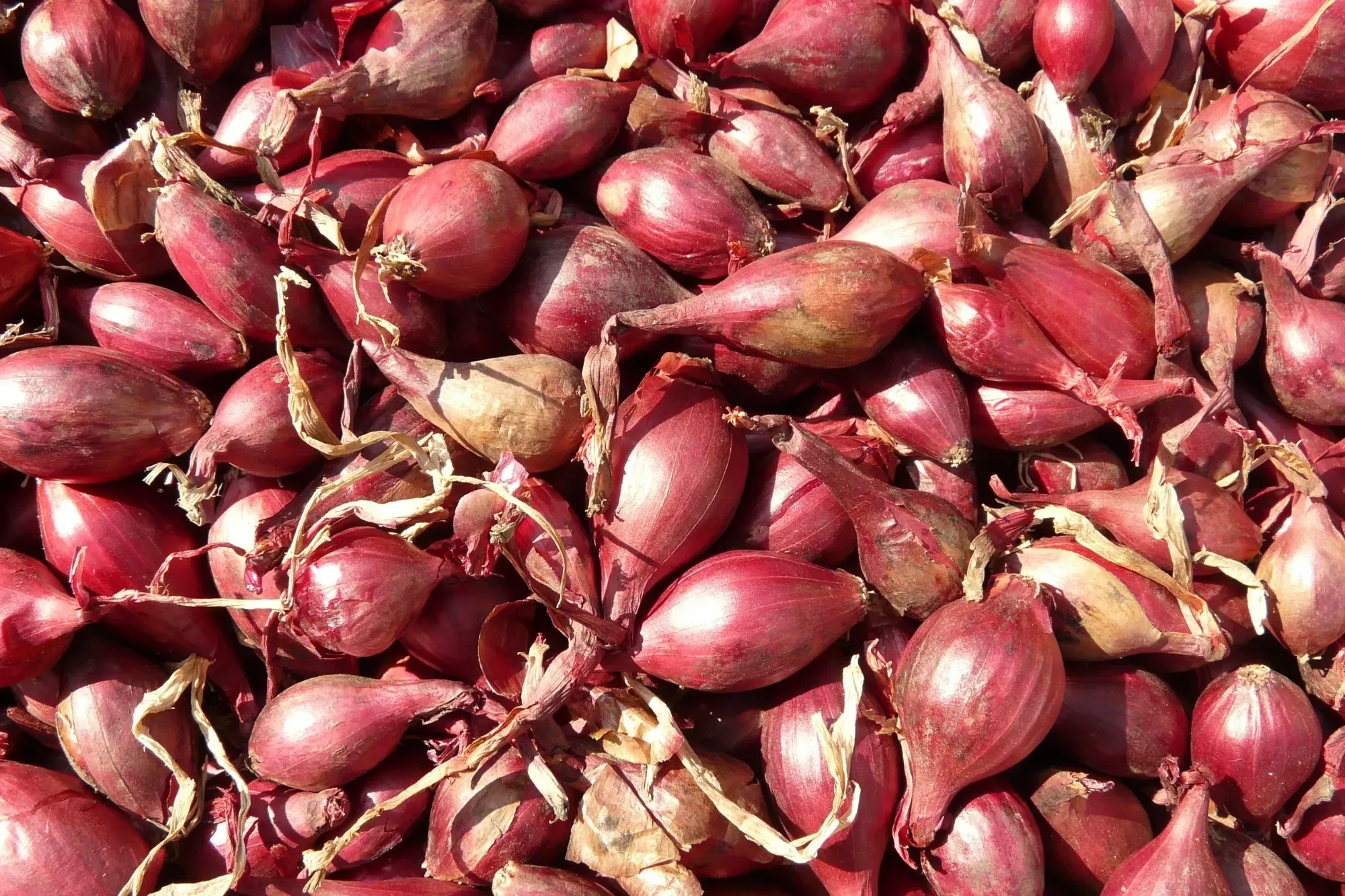
What Does It Taste Like?
Sweet and less pungent than onions, with a subtle complexity.
Health Benefits
These small bulbs are packed with nutrition—rich in fiber, vitamins, minerals, and antioxidants.
Eating shallots may help boost your immune system and protect your body from illnesses like the common cold.
How Do Thais Use It?
Used in dressings, sauces, curry pastes, and as a base for many Thai dishes.
Storage Tips
Keep in a cool, dry place away from direct sunlight.
Here are some links to recipes that use shallots: Thai Laab Moo and Thai Jaew BBQ Dipping Sauce — check them out!
11. Onion (Hom Yai) – Sweet, Savory & So Versatile
Onion belongs to the same family as garlic and is considered one of the most important vegetables in kitchens around the world.
Its bold flavor and distinct aroma make it a staple ingredient in countless dishes across many cultures.

What Does It Taste Like?
Eating onions raw gives you a spicy, sharp bite with a strong, pungent smell.
But when cooked, they turn sweet, the spicy kick fades, and the strong smell mellows out.
Health Benefits
Onions are a great source of vitamin C and also contain beneficial compounds like quercetin, which acts as a powerful antioxidant.
These nutrients help protect the body from various illnesses and support overall health.
How Do Thais Use It?
Onions are super versatile—you can use them in everything from snacks to main dishes.
Whether you’re boiling, frying, stir-frying, or making a spicy salad, onions work great both raw and cooked!
Storage Tips
Unused onions should be stored in a dry, well-ventilated place.
But if you have leftover onions after cooking, don’t just throw them away!
To keep them fresh, wrap the leftovers tightly with plastic wrap, place them in a plastic container, and store them in the fridge.
This helps prevent the onions from drying out or going bad.
Here are some links to recipes that use shallots: Chicken Potato Soup and Ginger Stir-Fried Chicken — check them out!
12. Fingerroot (Krachai) – Traditional Herbal Root for Vitality
Fingerroot is a popular medicinal herb grown in China and Southeast Asia.
It is an underground stem used in Thai cooking for its distinctive aroma and taste.
The shape of the rhizome resembles that of fingers.
It’s not just a flavor booster—it also supports health and can help repel insects.
In the west it is usually found pickled or frozen.

What Does It Taste Like?
With a spicy and slightly bitter kick
Health Benefits
Boosts energy, supports male health, anti-microbial
How Do Thais Use It?
Thais often enjoy it crispy-fried (like crispy basil leaves), add it to spicy stir-fries with fresh peppercorns, sour curry, or Nam Ya sauce for rice noodles, and use it in curry pastes.
Fingerroot can be brewed into a healthy tea.
Storage Tips
Wash it thoroughly, soak in 1 teaspoon of salt water for 10 minutes, then rinse 1–2 more times.
Let it dry, wrap in paper towel or kitchen roll, place in a sealed container, and store in the fridge’s regular compartment.
It will keep fresh for several months.
Here is a link to recipe that use fingerroot: Sour Curry — check it out!
13. Kaffir Lime Leaves (Bai Makrut) – Aromatic Herb with a Spicy Kick
Kaffir lime leaves are an essential ingredient in Thai cuisine, giving curries and stir-fries their distinctive fragrant aroma.
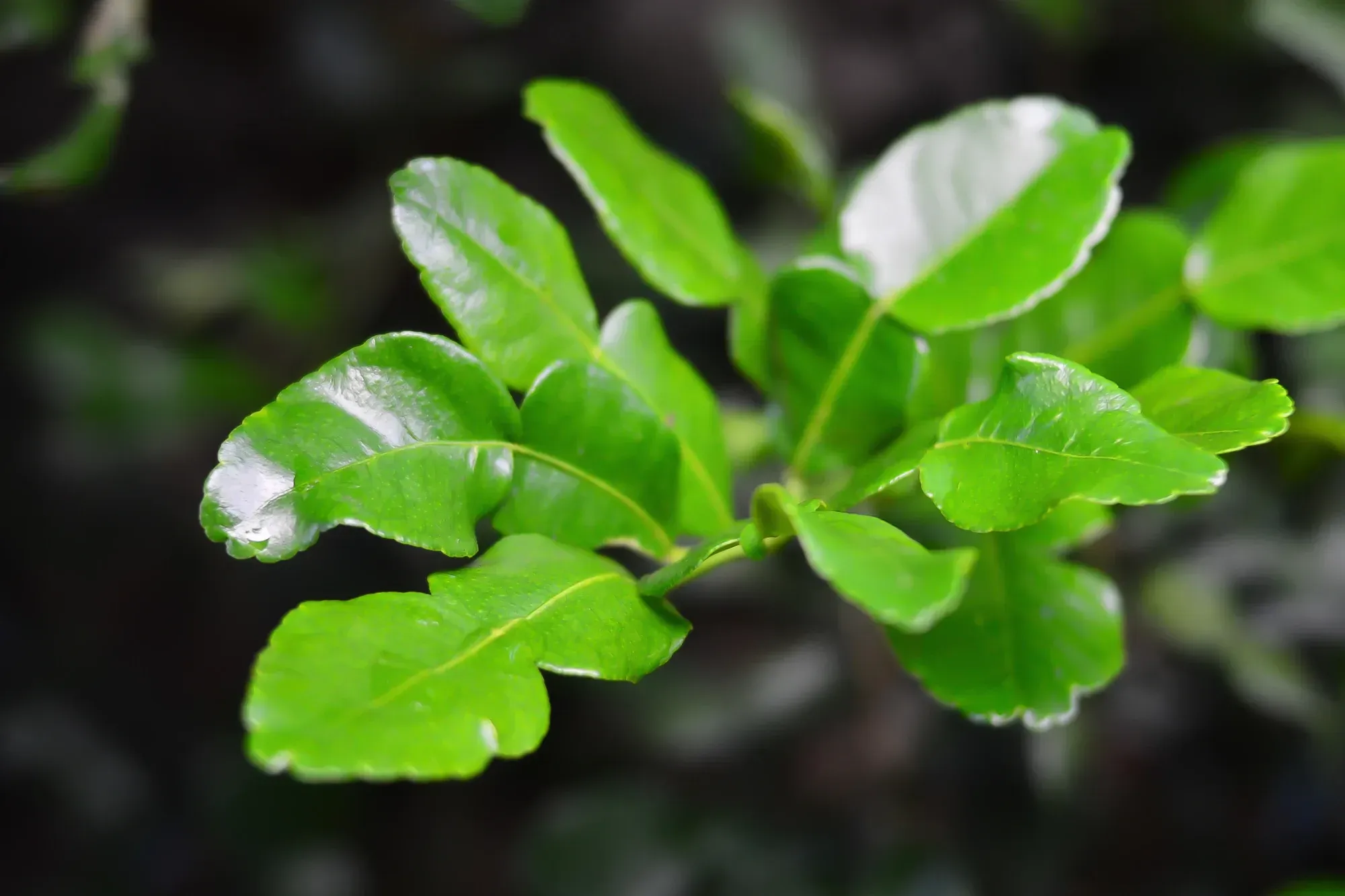
What Does It Taste Like?
Kaffir lime leaves are a fragrant and spicy herb.
Health Benefits
They’re packed with beta-carotene, which helps slow the growth of cancer cells and offers anti-cancer benefits.
How Do Thais Use It?
As a key ingredient in Thai cooking, kaffir lime leaves give curries and stir-fries their unique aroma—whether fried, stewed, or used to marinate meat.
Commonly used in many Thai dishes like Fish Cakes, Corn Fritters, Tom Yum, Green Curry, and Sour Curry.
They’re also rich in compounds that promote healthy skin.
Storage Tips
To keep kaffir lime leaves fresh for months, wash them thoroughly, let them dry completely, stack them, and store in a ziplock bag in the freezer for up to a year.
Here are some links to recipes that use kaffir lime leaves: Green Chicken Curry and Corn Fritters — check them out!
14. Kaffir Lime (Makrut) – Fragrant Citrus Boosting Flavor & Wellness
Kaffir Lime is a citrus plant with a mild fragrant aroma. Its fruit is round with a bumpy skin.
Both the peel and leaves have a fragrant scent used to flavor food and in traditional medicine.
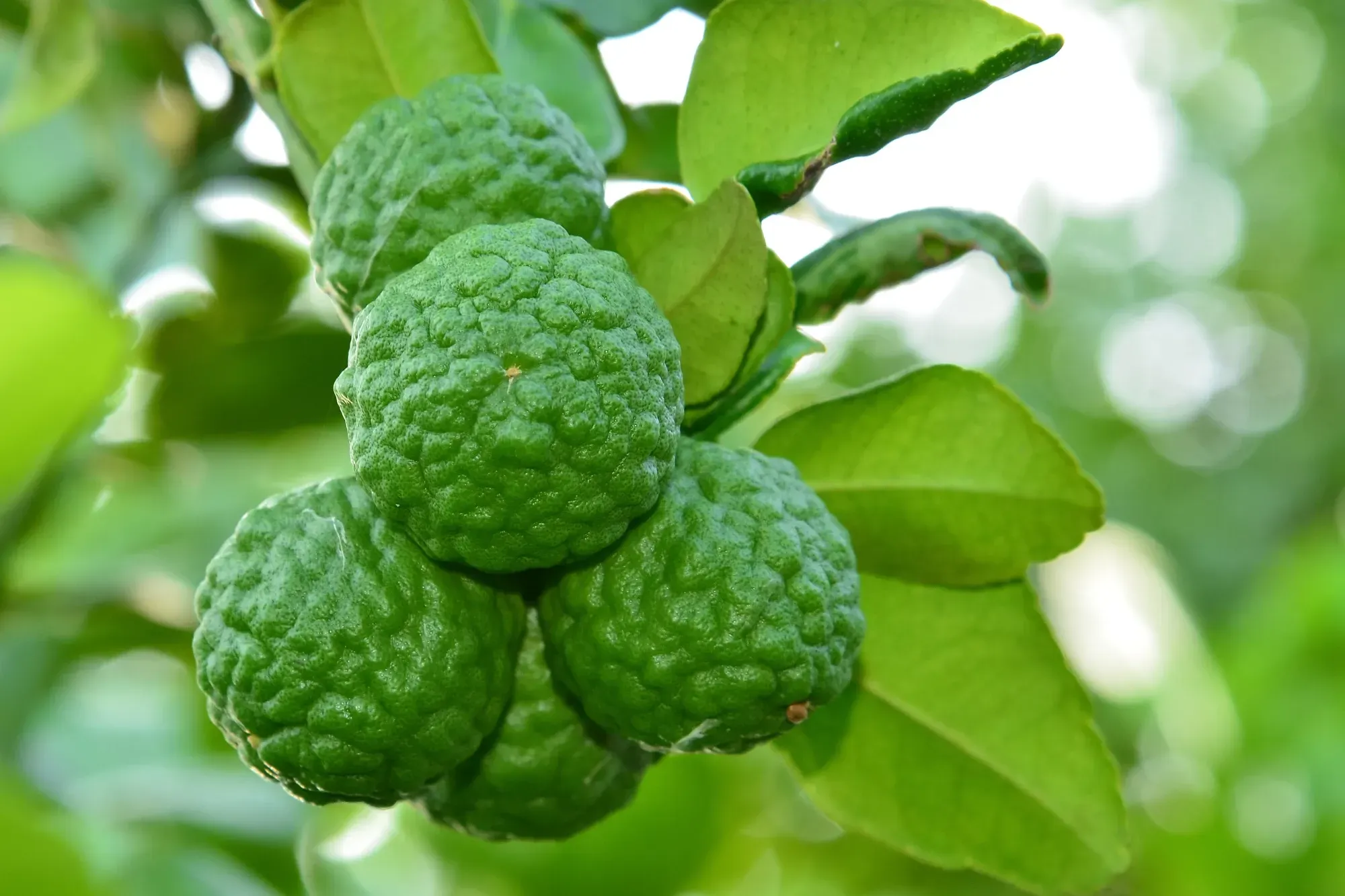
What Does It Taste Like?
The juice tastes sour.
Health Benefits
Kaffir lime is rich in antioxidants that help boost your immune system and fight off illnesses.
It can also stimulate appetite, and its essential oils are known for relieving stress.
How Do Thais Use It?
This well-known Thai herb is often used in cooking, health care, and beauty.
Kaffir lime juice is commonly added to dishes like rice noodles with chili sauce and certain curries.
The peel is a popular ingredient in Thai curry pastes, such as green curry.
Storage Tips
To store kaffir lime peel, wash and dry it thoroughly.
Remove the peel from the fruit, then place it in a zip-lock bag and freeze it—it can last for months.
Here are some links to recipes that use kaffir lime: Kaffir lime Juice and Curry Pastes — check them out!
15. Mint (Saranae) – Fresh Flavor with Cooling Benefits
Mint is a creeping ground cover plant that spreads out with branching stems, forming a dense patch.
It’s a natural herb whose leaves and essential oils have been used for health benefits for a long time.
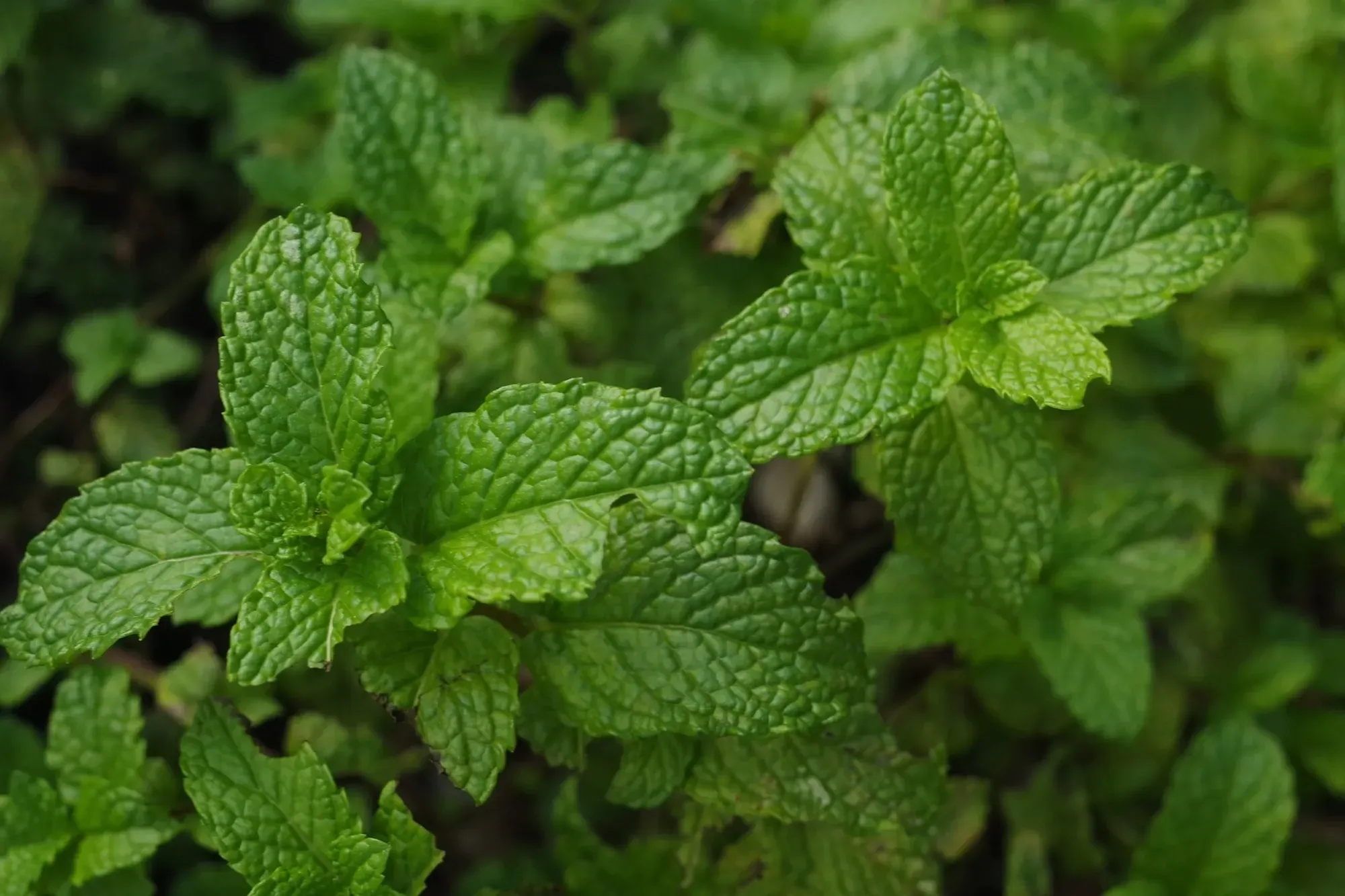
What Does It Taste Like?
It has lemon-scented leaves and a spicy, cooling flavor similar to menthol, with tastes that remind you of lemongrass and lime.
Health Benefits
Mint helps treat bronchitis, supports a healthy heart, and relieves physical fatigue.
How Do Thais Use It?
With its refreshing aroma and health benefits, mint is popular for many uses — from cooking and extracting essential oils to garnishing drinks.
Storage Tips
To store mint, place the sprigs in a bottle with a little water at the bottom, seal the lid, and keep it in the fridge.
Or, wash the leaves gently, pat dry, place them in a container lined with kitchen towels on the bottom and top, seal it, and store in the fridge’s regular compartment.
Here are some links to recipes that use mint: Authentic Thai Laab Moo and Mojito — check them out!
16. Turmeric (Khamin) – Golden Spice with Powerful Health Benefits
Turmeric is a well-known kitchen herb in Thailand, packed with vitamins and minerals.
It’s loved in cooking for its beautiful color and fragrant, spicy aroma.
Turmeric is also a key ingredient in traditional Thai herbal medicine, known for its ability to prevent and treat various health conditions.
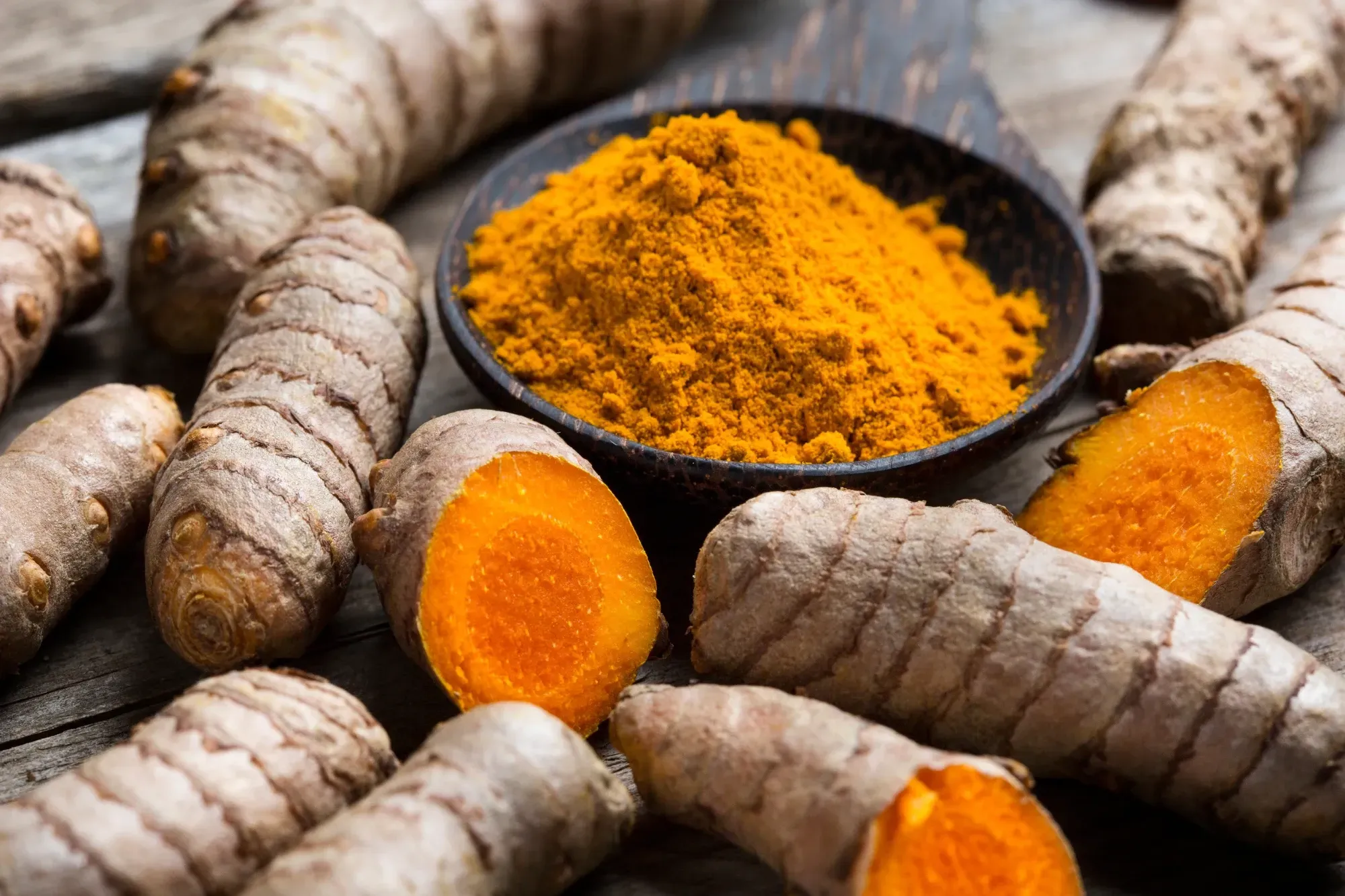
What Does It Taste Like?
It has a slightly sweet, astringent flavor with a pleasant aroma.
Health Benefits
Turmeric is rich in antioxidants that help slow aging and reduce wrinkles.
It also boosts the immune system and promotes healthy, strong skin.
How Do Thais Use It?
Fresh turmeric roots can be mixed into curry pastes, used as a meat marinade, or dried and ground into powder for seasoning dishes or coloring food.
Storage Tips
Just wash it clean, let it dry, store it in an airtight container, and freeze—it can last for a year or more!
Here are some links to recipes that use turmeric: Khao Soi, Yellow Curry, and Sai Au — check them out!
17. Pandan Leaves (Baitoey) – Fragrant, Fresh, and Soothing
Pandan is a small tropical plant that grows in clusters, with long, single green leaves spiraling gracefully upward.
Its vibrant green color feels refreshing to the eyes, and the leaves are naturally sweet-smelling.
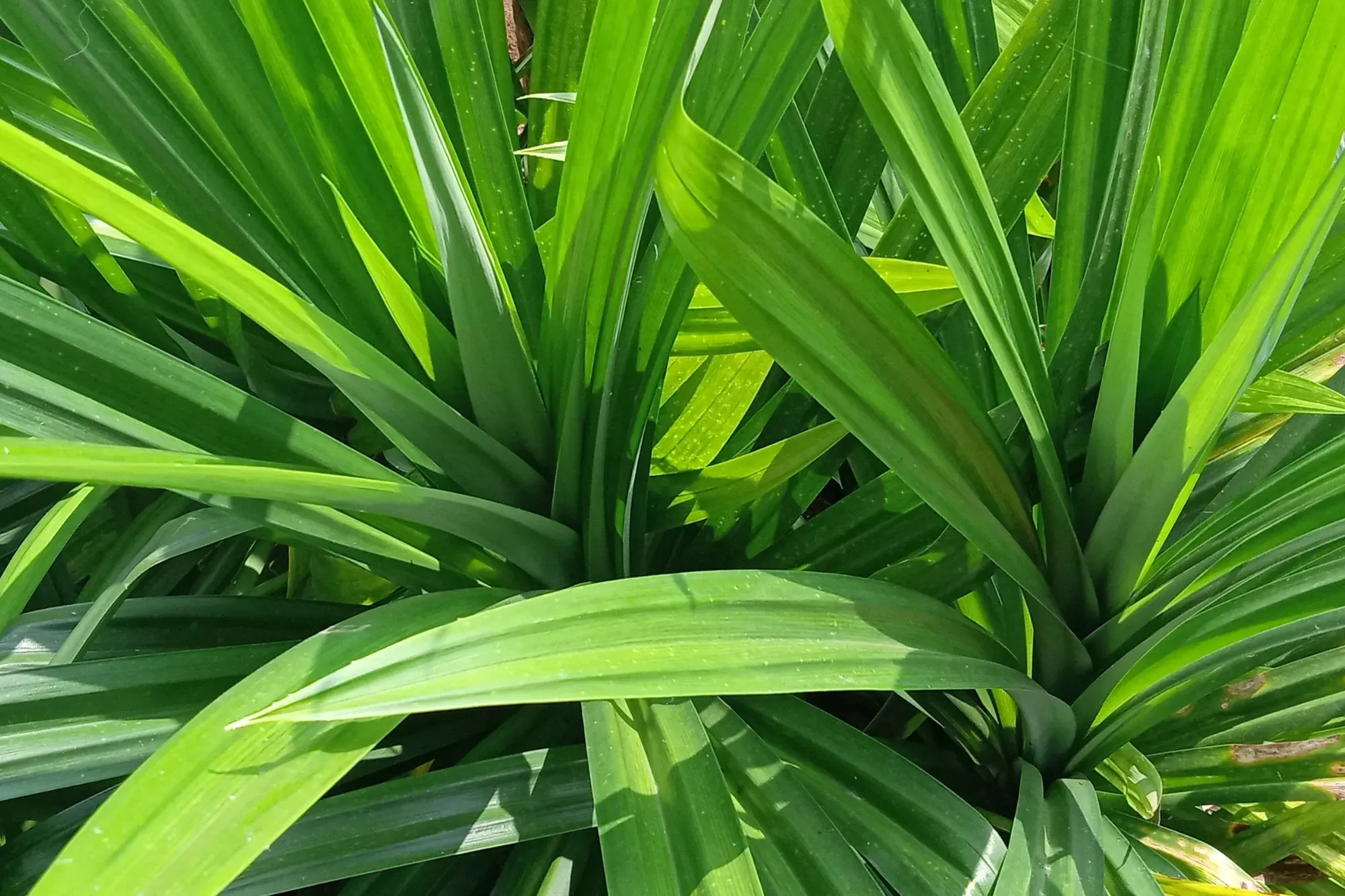
What Does It Taste Like?
Pandan leaves not only have a wonderfully fragrant aroma and a beautiful green color, but they also offer a naturally sweet and cooling flavor.
Health Benefits
Pandan tea is believed to help cool the body, support heart health, and reduce heart rate.
It’s a soothing and gentle remedy used in traditional wellness practices.
How Do Thais Use It?
In Thai culture, pandan leaves are incredibly versatile.
They’re used to add a pleasant aroma to the air, as natural wrappers for desserts, as a fragrant tea or infusion, in soups and stews for flavor, or even to naturally color food.
Storage Tips
To store, peel the leaves one by one, rinse well, then wrap them in a damp towel and keep them in the fridge.
For longer storage, freeze them—they’ll last for months and keep their aroma and color.
Here are some links to recipes that use pandan leaves: Thai Soft Coconut Crepes and Pandan Leaves Juice — check them out!
18. Fresh Green Peppercorns (Prink Thai Sod) – Zesty, Aromatic, and Naturally Spicy
Fresh green peppercorns (sometimes called “fresh” or “raw” pepper) are the young, unripe fruit of the pepper plant.
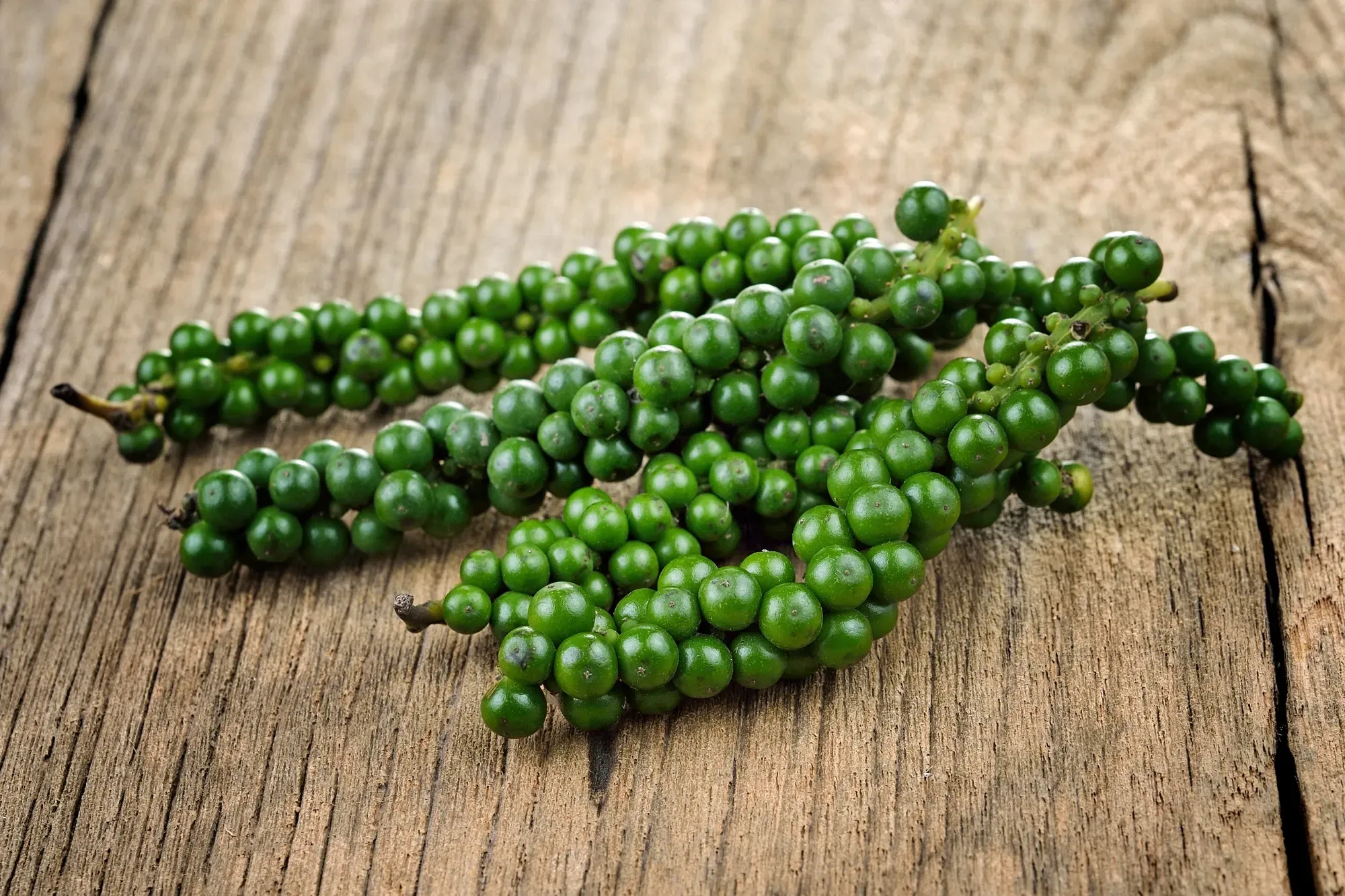
What Does It Taste Like?
Green peppercorns bring a well-rounded peppery flavor—aromatic, slightly spicy, and not overly hot.
Health Benefits
They also offer health benefits like promoting digestion, relieving bloating, improving circulation, and helping reduce fever.
Their natural antimicrobial properties can even help preserve food.
How Do Thais Use It?
With their green skin still intact, these peppercorns can be chewed whole and are often used in Thai cooking to add a bold aroma and mild heat.
They help mask strong odors from meats or seafood and are often sold in beautiful clusters, making them great for garnishing dishes too.
Storage Tips
They can be used whole or lightly crushed. The flavor is slightly pungent, with a zesty, cooling bite.
To prepare, simply rinse and let them dry before cooking. For storage, wrap them in paper, place in a plastic bag, and keep in the fridge’s veggie drawer to stay fresh longer.
Here is a link to recipe that use fresh green peppercorns: Stir-Fried Curry with Thai Herbs — check it out!
19. Dill (Pak Chee Laos) – Fresh, Fragrant, and Full of Zing
Dill is a leafy herb loved around the world. While it may not be the star ingredient in most dishes, its vibrant aroma and refreshing flavor make it a key element in many flavorful meals.

What Does It Taste Like?
Dill is often used to enhance the aroma of food. It has a lightly sweet and peppery taste.
Health Benefits
Dill is packed with antioxidants, which help slow down aging.
It’s also rich in vitamin A, making it great for eye health.
How Do Thais Use It?
Both the stems and leaves can be eaten fresh—often paired with spicy Thai chili dips or added to curries for an herbal kick.
In Thailand, it’s especially popular fresh alongside dishes like larb or with flavorful dipping sauces, adding a bright, fresh note to any meal.
Storage Tips
Wrap dill in a damp paper towel (like kitchen roll), then place it in a plastic bag with holes or a zip-top bag—just don’t seal it too tightly, so it stays well-ventilated.
Here are some links to recipes that use dill: Spicy Minced Pork Salad (Laab/Larb) or Smoked Salmon Cream Cheese Pastries — check it out!
20. Garlic Chives (Guichai) – Pungent, Warming, and Packed with Nutrients
A green vegetable that looks similar to green onions. Garlic chives are a pungent, heaty vegetable in the same family as onions and garlic.
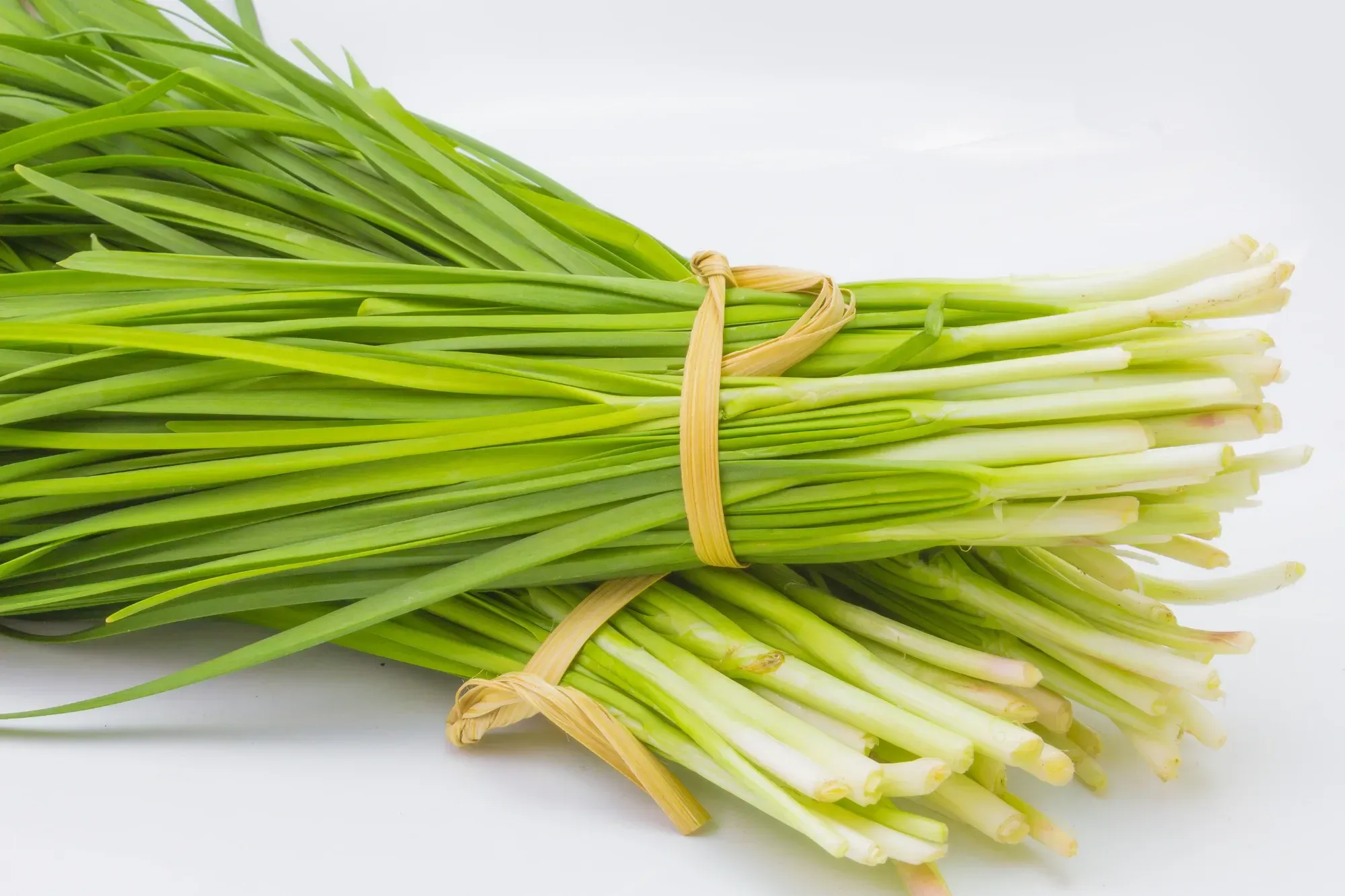
What Does It Taste Like?
Earthy and peppery
Health Benefits
They’re rich in iron, which helps the body produce red blood cells and fight fatigue.
They’re also high in beta-carotene and vitamin C, making them a great choice for overall health.
How Do Thais Use It?
Garlic chives can be used in both savory dishes and snacks—think stir-fried with pork liver, added to Pad Thai for extra flavor, or turned into delicious garlic chive dumplings.
Storage Tips
If you don’t use them all at once, wash thoroughly, let them dry, and separate the roots from the leaves.
Cut into portions you’ll need next time, store them in a zip-top bag, and freeze—they’ll keep well for several months.
Here are some links to recipes that use garlic chives: Pad Thai, Stir-Fried Leeks, and chive dumplings— check it out!

